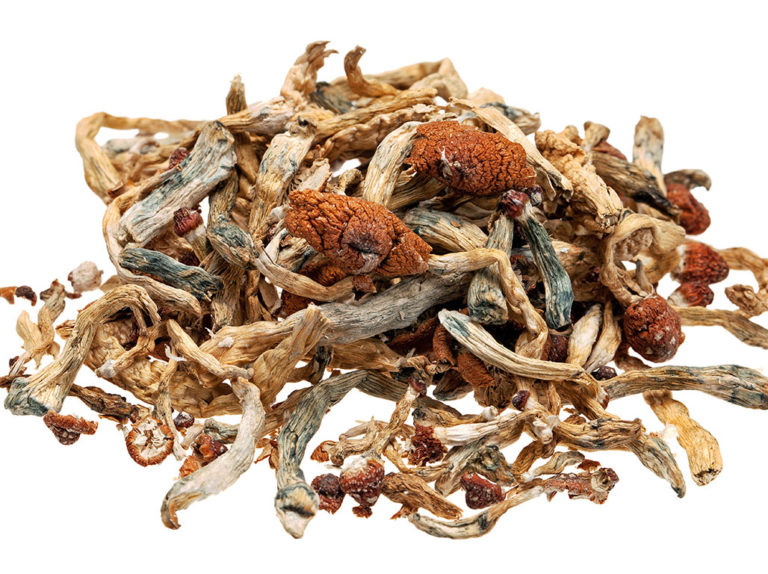The ingredients in hallucinogenic magic mushrooms are two closely related substances, psilocybin and psilocyn. These components are found in more than 75 known species of mushrooms native to tropical and subtropical areas of South America, Mexico, Southeast Asia, Europe, and the United States1. The potency of mushrooms varies, but most have .2% to .4% psilocybin and only trace amounts of psilocyn. According to the DEA, while street prices fluctuate, psilocybin mushrooms generally cost $20 for 1/8 ounce and $100 to $120 for an ounce. In addition, synthetic psilocybin and psilocyn can be produced, although this practice is rare because the process is difficult and expensive, and the end product is difficult to store2. In its pure form, psilocybin is a white crystalline powder3.
History
Historically, Central and South American Indians have considered hallucinogenic mushrooms, called “god’s flesh,” to be sacred. Mushrooms have been used in social and religious rituals to produce visions to aid in treating illnesses, solving problems, and contacting the spirit world. In the mid-1950s, Albert Hofmann, who is credited with discovering LSD [link to JF LSD page], isolated the active ingredients of mushrooms and determined psilocybin to be the major hallucinogenic component in the mushrooms, and psilocyn to be a minor component. Once in the body, psilocybin becomes unstable and converts into psilocyn. Psilocyn, which is 1.4 times as potent as psilocybin, is thought to be the source of the physical and psychological effects produced by hallucinogenic mushrooms4. By 1968, psilocybin mushrooms were made illegal because of the excessive amount that were being abused. Although psilocybin and psilocyn are scheduled under the Controlled Substances Act of 1970 as Schedule I drugs, the mushrooms themselves are not scheduled5.
Effects
Psilocybin affects the central nervous system by disturbing the normal interaction of nerve cells and the functioning of the neurotransmitter serotonin, to which it is structurally similar8. The effects produced by psilocybin and psilocyn are highly variable and depend on several factors, including the age, type, and dosage amount of mushroom used, the setting the mushroom is used in, the users expectations, past drug experiences, and personality. The effects of synthesized psilocybin and psilocyn are more predictable. Mushrooms can take 20 minutes to 2 hours to take effect, and will last for 3 to 6 hours9.
Physical effects include
- Nausea, vomiting, abdominal cramps, and diarrhea
- Muscle relaxation, weakness, and twitches
- Yawning, drowsiness, dizziness, lightheadedness, and lack of coordination
- Pupil dilation, tearing, dry mouth, and facial flushing
- Increased heart rate, blood pressure, and body temperature
- Sweating followed by chills and shivering
- Numbness of tongue, lips, or mouth
- Feelings of physical heaviness or lightness and feelings of floating
Psychological effects include
- Heightened sensory experiences and perceptual distortions (i.e. brighter colors, sharper visual definition, increased hearing acuity, more distinguished taste)
- Auditory, tactile, and visual hallucinations
- Synesthesia (melding of the senses: seeing music or hearing colors)
- Difficulty focusing, maintaining attention, concentrating, and thinking
- Impaired judgment and preoccupation with trivial thoughts, experiences, or objects
- Sense of detachment from body and surroundings and loss of boundaries between the two
- Altered perception of space and time
- Inability to distinguish fantasy from reality
- Melding of past experiences with present
- Feelings of unity with the environment
- Feelings of involvement with intense spiritual experiences
- Tension, anxiety, and restlessness
- Highly adverse reactions (“bad trip”), including frightening hallucinations, confusion, disorientation, paranoia, agitation, depression, panic, and/or terror
Methods of Use
Fresh or dried psilocybin mushrooms can be ingested orally either whole (often prepared with a food item such as peanut butter or pizza to hide their bitter taste), sprinkled on top of food, or after being brewed to make a tea. Dried mushrooms can also be crushed into a powder and prepared in capsule form. In its pure powder form, psilocybin can be prepared in capsules, tablets, or solution. Psilocybin can be consumed orally, sniffed, smoked, or injected.
Terminology
- Hallucinogenic mushrooms/psilocybin/psilocyn
- Boomers, caps, cubes, gods flesh, liberty caps, little smoke, magic mushrooms, Mexican mushrooms, mushrooms, musk, sacred mushroom, sherm, shrooms, silly cybin, silly putty, simple simon
- Psilocybin mushroom powder mixed in fruit juice1
- Fungus delight
Use of psilocybin mushrooms mixed with ecstasy
- Flower flipping or hippie flip
Tolerance, Dependence, & Withdrawal
With regular and repeated use of psilocybin mushrooms, tolerance to the effects will occur. In addition, cross-tolerance occurs with other drugs, including LSD and mescaline. Without a period of abstinence from mushrooms and these other drugs, no amount of hallucinogens will produce a psychedelic effect. However, with a period of discontinued use, initial effects can be achieved again. There are no reports that psilocybin mushrooms are psychologically or physically addictive, and use does not lead to dependence. For several days following the use of mushrooms, users may experience a period of psychological withdrawal and have difficulty discerning reality.
Courtesy They University of Maryland
If you or someone you know needs help with addiction to substances, visit Recovery Guidance for a free and safe resource to find addiction and mental health professionals near you.
Save
Save





















